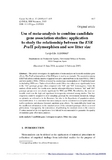Mostrar el registro sencillo del ítem
Use of meta-analysis to combine candidate gene association studies: application to study the relationship between the ESR PvuII polymorphism and sow litter size
| dc.creator | Alfonso Ruiz, Leopoldo | es_ES |
| dc.date.accessioned | 2014-05-14T07:34:59Z | |
| dc.date.available | 2014-05-14T07:34:59Z | |
| dc.date.issued | 2005 | |
| dc.identifier.issn | 0999-193X (print) | |
| dc.identifier.issn | 1297-9686 (electronic) | |
| dc.identifier.other | 853 | |
| dc.identifier.uri | https://hdl.handle.net/2454/10528 | |
| dc.description.abstract | This article investigates the application of meta-analysis on livestock candidate gene effects. The PvuII polymorphism of the ESR gene is used as an example. The association among ESR PvuII alleles with the number of piglets born alive and total born in the first (NBA1, TNB1) and later parities (NBA, TNB) is reviewed by conducting a meta-analysis of 15 published studies including 9329 sows. Under a fixed effects model, litter size values were significantly lower in the "AA" genotype groups when compared with "AB" and "BB" homozygotes. Under the random effects model, the results were similar although differences between "AA" and "AB" genotype groups were not clearly significant for NBA and TNB. Nevertheless, the most noticeable results was the high and significant heterogeneity estimated among studies. This heterogeneity could be assigned to error sampling, genotype by environment interaction, linkage or epistasis, as referred to in the literature, but also to the hypothesis of population admixture/stratification. It is concluded that meta-analysis can be considered as a helpful analytical tool to synthesise and discuss livestock candidate gene effects. The main difficulty found was the insufficient information on the standard errors of the estimated genotype effects in several publications. Consequently, the convenience of publishing the standard errors or the concrete P-values instead of the test significance level should be recommended to guarantee the quality of candidate gene effect meta-analyses. | en |
| dc.format.mimetype | application/pdf | en |
| dc.language.iso | eng | en |
| dc.publisher | EDP Sciences | en |
| dc.relation.ispartof | Genetics Selection Evolution, 2005, 37 (4). Págs. 417-435 | en |
| dc.rights | © INRA, EDP Sciences, 2005 | en |
| dc.subject | Meta analysis | en |
| dc.subject | Candidate gene | en |
| dc.subject | Estrogen receptors | en |
| dc.subject | Litter size | en |
| dc.subject | Pigs | en |
| dc.subject | Quantitative trait loci | en |
| dc.subject | Estrogen receptor locus | en |
| dc.subject | Population admixture | en |
| dc.subject | Reproductive traits | en |
| dc.subject | Placental traits | en |
| dc.subject | Complex traits | en |
| dc.subject | Pig breeds | en |
| dc.subject | Landrace | en |
| dc.subject | Genotypes | en |
| dc.subject | Swine | en |
| dc.title | Use of meta-analysis to combine candidate gene association studies: application to study the relationship between the ESR PvuII polymorphism and sow litter size | en |
| dc.type | Artículo / Artikulua | es |
| dc.type | info:eu-repo/semantics/article | en |
| dc.contributor.department | Producción Agraria | es_ES |
| dc.contributor.department | Nekazaritza Ekoizpena | eu |
| dc.rights.accessRights | Acceso abierto / Sarbide irekia | es |
| dc.rights.accessRights | info:eu-repo/semantics/openAccess | en |
| dc.identifier.doi | 10.1051/gse:2005009 | |
| dc.relation.publisherversion | https://dx.doi.org/10.1051/gse:2005009 | |
| dc.type.version | Versión aceptada / Onetsi den bertsioa | es |
| dc.type.version | info:eu-repo/semantics/acceptedVersion | en |


